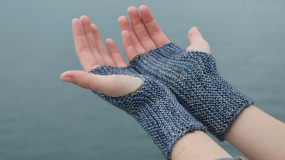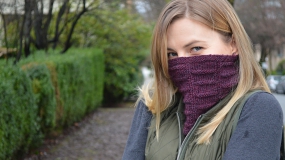blocking 101
here’s how to do it.
you take the scarf, shirt, whatever, and dump it into your bathroom sink. no, wait, draw some warm water first and then dump it in. you don’t want that baby felting. don’t worry if there are toothpaste stains or other smears in the sink, as it’s probably not enough to ruin the fabric anyway. let it soak for a good 15-20 minutes, kneading it firmly every now and then to remove any air bubbles. muscle relaxants will help time go faster.
at this point you’ll notice that you forgot to thread the edges. you may also know that it’s difficult to thread wet fabric, or if you don’t know, you will soon enough. so take the piece out, dry it using your preferred method and thread the edges you want to keep straight. then soak the piece again.
once the piece is completely soaked, take it out and roll it inside a towel to squeeze out excess water. stomp on it to a couple of times – keep your socks on while doing so as they will help absorb more water. lay another towel on the floor and spread the piece on it. pull the threads tight and start pinning down the edges. make sure to jam the pins deep into the flooring underneath, as this will make the hold more secure. some people use a ruler or a tape measurer to keep the proportions even. i trust my eyes more than some piece of plastic, but this of course is up to your discretion.
if you took the relaxants, you will start feeling a bit drowsy right now. don’t worry. that’s part of the fun.
unless you were able to insert all the pins in less than 5 minutes, the piece will have dried too much by now, especially if you’re blocking lace. you probably don’t want to do the soak for a third time, nor do you want to take all the pins out again, so you could just try spraying the piece with a spray bottle. however, silk fibers especially need to be thoroughly wet, so just to be safe i would recommend rinsing the bastard with a watering can (a garden hose would work too). pour at least a few gallons directly over the piece, or until the color of the yarn has gone darker throughout. of course, everything on a two-meter radius will be flooded, along with two apartments below you, but even the most stubborn fibers will now be thoroughly wet, which is crucial.
the wet part of the blocking process is now over. getting the piece to dry into its newly stretched form will be a small pickle, now that the piece and the towels and carpets and floorings under it are drenched. first give it a good 24 hours to dry by itself. but unless you are blocking near a radiator or a window with direct sunlight, you will need additional help from the hairdryer. you shouldn’t need to use it for more than 4-5 hours.
once the piece is completely dry, take out the pins and remove the threads, using force if and when necessary. weave in all unwoven ends. be sure to leave a few pins on the floor! finding them will be a fun game for kids and pets. if all has gone well, your newly blocked garment will only have lost some of its original sheen and texture, and will have a lovely minty scent.
finally, take your head out of your ass, go to this address and start over. because my technique sucks some epically major balls.













Ahhh STRINGS!!!! Much safer than long and pointy blocking wires and my drug addled brain. Why has no one mentioned this before?!